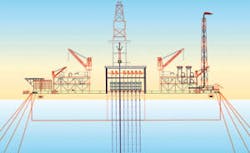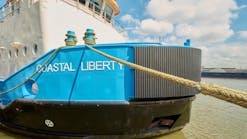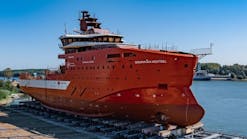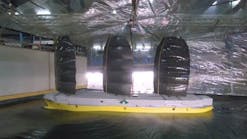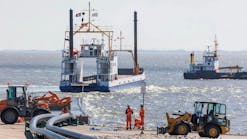Side view of the Multifunction Barge
- Monocolumn in the Gulf of Guniea with drilling/workover tender barge.
- The Semisubmersible Assembled on Site.
New concepts designed for flexibility, long service
Following the renaissance of concrete barges with the N'kossa production unit, Bouygues Offshore has introduced three new concepts suited to much deeper waters in the Gulf of Guinea. Two of them could even work side by side.N'kossa's barge, which is the largest concrete monohull ever built, has operated without problems since production started almost a year ago. The rectangular vessel measures 220 meters long by 46m wide and 16m deep, has an operating displacement of 110,000 tonnes and can carry a deck load of 33,000t.
Elf Congo chose concrete because the Bouygues Offshore design promised at least 30 years' uninterrupted service on the field, with high fatigue resistance and minimal maintenance. Also, the barge concept allowed assembly, hook-up and commissioning of production modules to be performed alongside the quay at the construction site in France, reducing final preparation times once at the field. The barge produced first oil within two months of being moored on the N'kossa Field.
Multifunction barge
In association with Sedco-Forex and IFP, Bouygues Offshore has now advanced the concept several stages further with the Multifunction Barge. This is another concrete monohull that combines the N'kossa vessel functions (oil and gas treatment, utilities and living quarters) with crude storage and offloading, as on an FPSO. Most importantly, it also incorporates drilling, tie-back, completion and workover facilities.The Multifunction Barge would normally work in waters 1,000 meters deep, although it could be adapted for the range 500-2,000 meters. These depths, allied to the mild environmental conditions encountered in the Gulf of Guinea, allow the wellheads to be located above the deck in a central moonpool with rigid risers to the seabed.
Drilling and production would be performed simultaneously, with up to 40 well slots available. Crude produced at a peak rate of 150,000b/d would be stored in the 1,500,000 bbl capacity hull, with concrete bulkheads used to form water-tight tanks. Offloading operations would be by tandem-moored tankers.
To limit vertical relative motions between the barge and wellheads, the vertical distance from the barge to the seabed is maintained by water ballasting, which compensates for the effects of tide and fluctuating storage volumes. Small water ballasting tanks in the hull shield the cargo tanks against any damage that might be inflicted on the side of the hull or the moonpool area.
Sixteen chain/cable catenary lines positioned at each of the barge's corners are fixed to the seabed by suction anchors, and connected to the hull through deck fairleads and tensioners. The mooring system purposely offers high horizontal stiffness, which allows a smaller wellhead setdown.
High performance concrete would be applied in the hull, which would also be heavily reinforced and post-tensioned to withstand overall and local environmental forces as well as functional loads applied to the structure. As concrete offers better insulation levels than steel, heat losses in the crude storage tanks would be greatly reduced. This is an important consideration in view of worries over wax formation in the West African deep offshore (Wado).
The spacious deck area is designed for an uncongested topsides arrangement, with a simple interface between the topsides and the hull. The extensive deck area, allied to high stability levels (with minimal sensitivity to weight changes) also permits late definition of topsides weight and layout. Equipment retrofits for future tie-ins can easily be accommodated. When fully laden, the barge can safely handle topsides weighing up to 20,000 tons. These topsides would be built as single level, pancake-type pre-assemblies, or as modules suitable for transport on a standard cargo barge.
Riser analysis, using IFP's Flexan software, has led to satisfactory design of drilling and production risers, according to Bouygues Offshore, with riser spacing of around 5 meters. Risk evaluation of the whole concept to date suggests a similar risk level to other concepts proposed for West Africa, such as an FPSO linked to a mini-TLP. Elf, BP, Shell and Statoil have all participated in funding of the Multifunction Barge, as part of the WADO project.
Monocolumn alongside
As an accessory to the Multifunction Barge or another FPSO, Bouygues Offshore proposes its Monocolumn Wellhead Platform. This combination would also provide an alternative to the much-vaunted mini-TLP.The platform comprises a concrete column, measuring 200 meters long and 14m in diameter, supporting a 2-3,000 ton deck designed by Technip-Geoproduction. The normally unmanned deck would house minimal separation and water injection facilities, with crude exported to the central production platform through a steel catenary riser.
Mooring of the monocolumn would be provided by a spread catenary system composed either of steel spiral strand cable and chain or, for greater efficiency, synthetic ropes and chains. To minimize interference with the mooring system of the attendant drilling/workover unit, fairleads would be located 50 meters below sea level. This arrangement should also reduce dynamic loads brought on by pitching motions. The use of surface wellheads with vertical rigid production risers is made feasible by the very low dynamic motions of the platform.
Six to 12 dry trees could be accommodated, with risers running along the monocolumn's external envelope. These would be guided into place along the column through a series of guide frames. Buoyancy cans situated between the guiding devices at the upper end of the risers would provide tensioning.
The column would be constructed horizontally in a dry dock using pre-stressed, high performance concrete. To ensure stability during towout, also in the horizontal position, it would be divided into regular, watertight compartments by transverse bulkheads. On arrival at the field, it would be set upright through transferring water ballast from the top to bottom compartment. Once moored, a derrick barge would place the deck on top.
Fixed heavy ballast at the monocolumn's bottom, and water ballast in the three lower compartments, would further aid stability. The upper compartment could also be used for variable water ballast, according to variations in the deck load. In addition, this upper compartment would feature an inner steel compartment forming a double hull, ensuring stability and buoyancy should the platform be flooded accidentally. These arrangements should also allow it to withstand sudden deckload changes which may occur during drilling.
Tank tests on a 1/60 scale model of the monocolumn in Ifremer's Brest facility in France have proven its good behavior characteristics. Extreme motions under a 100-year storm were to within 0.6m for heave and to within 1.9! for pitch, sufficient to allow use of rigid risers. Extreme dynamic motions combined with tidal effects would generate extreme relative motions between the wellheads and deck of 4.4m.
According to Bouygues Offshore, construction costs for the concrete floater would be low as it could be built in one piece in a dry dock. Also, the geometry is simple, and the deck is similar to those used on conventional jackets. The concept might appeal particularly to those oil companies either planning a staged development in the Gulf of Guinea using several dispersed drilling facilities, or developing marginal fields close to existing production facilities.
Deepwater semi
Finally, for the same Gulf of Guinea scenario (500-2,000 meters), Bouygues Offshore has developed the Semisubmersible Assembled on Site (SAS) in association with EAP, Ifremer, Principia and Technip-Geoproduction. This floating, drilling and production platform comprises an integrated steel deck borne by four 200m concrete columns. The load would be managed through use of a special articulation joint formed by reinforced laminated neoprene blocks, with a rotation capability of up to three degrees.Bouygues Offshore claims this concept would be cost-competitive with a TLP or SPAR for a 20-well, 100,000b/d production plant, due partly to the mating technique, but also due to the use of independent column floaters which could be built at different sites from the deck.
These columns, again made from pre-stressed, high performance concrete, would have an OD of 14 meters and wall thickness of 0.4-0.5m, without the need for internal stiffeners. They could be constructed horizontally. The hull of the 88.5m long, 50m wide steel deck would be composed of orthogonally stiffened flat panels suited for modern automated panel production fabrication methods.
Process equipment would include oil separation, gas treatment and compression, produced water treatment, seawater lift, filtration, de-aeration and injection systems. An SAS operating in 1,000 meters of water would handle 100,000b/d of oil, 105mcf/d of gas, 75,000b/d of produced water and 150,000b/d injection seawater. Produced oil, however, would have to be stored on a nearby FSO for onward tanker offloading or export though a pipeline.
The wellbay with typically 20 well slots would be sited at the border of the platform deck, separated from process equipment by blast fire walls. Another blast fire wall would protect the LQ and utility area from the process facilities. Up to 60 people could be housed on the main deck at the opposite end to the risers and hazardous process areas.
Twelve mooring lines would be secured at the sea floor by suction anchors. The mooring system would be divided into four groups of three mixed lines (chain/steel wire rope/chain) at each corner of the deck, with the lines slightly splayed from the 45deg diagonal alignment. During installation, ends of each line cluster would be buoyed off a temporary floater.
Following towout to the site in a horizontal position, with a draft of around 7m, the column-floaters would be upended to a vertical position using ballasting. The barge-conveyed deck would be floated off and connected to the mooring lines, following which the vertical columns would be shifted under the corbel deck at each corner of the hull.
Mating would ensue through releasing ballast at the bottom end of the columns. These will be buoyed up instantly to contact the underside of the corbel deck, where shock absorbers will ensure dissipation of the kinetic energy at impact. Simultaneously, a second ballast is released to create a 1,000t compressive force in this contact area, preventing rebound and other multiple impacts. Finally, to obtain an operational gap of 6m for the deck hull, seawater would be deballasted from the columns, with mooring lines then re-tensioned to their design pre-tension.
Basin tests on the SAS in Ifremer's Brest facility indicated heave motion to within 0.35 meters for 99% of the time during drilling and other operations. Results suggested the concept could be eventually adapted to more severe environments than the Gulf of Guinea.
Copyright 1997 Oil & Gas Journal. All Rights Reserved.
